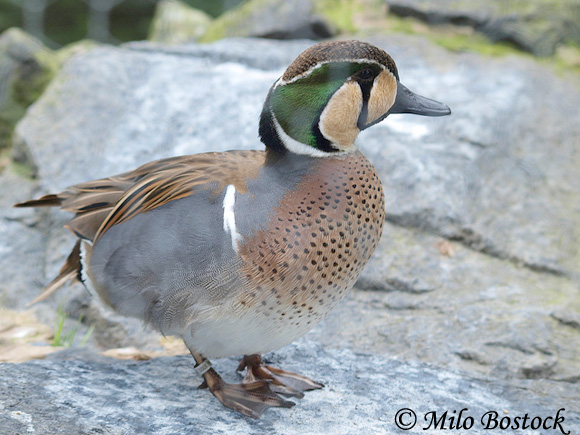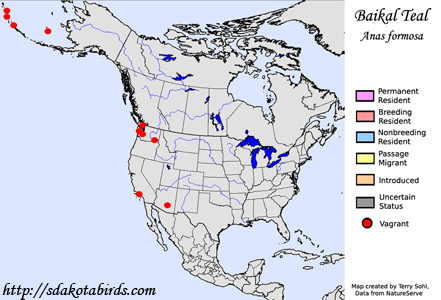| Length: 16 inches | Wingspan: 24 inches | Seasonality: Non-resident in South Dakota |
| ID Keys: Unique plumage on males, with green nape, tan face and dark crown, spotted breast, gray body with tan upperparts | ||
 The
Baikal Teal is a small duck of eastern Asia. They are extremely rare
vagrants to North America, with individual sightings occurring in the
Aleutians, but also in scattered locations in the western United States.
The
Baikal Teal is a small duck of eastern Asia. They are extremely rare
vagrants to North America, with individual sightings occurring in the
Aleutians, but also in scattered locations in the western United States.
Habitat: During the summer breeding season they are found in wetland areas in Siberia, including woody wetlands and tundra bogs. Found in a variety of wetland and open water habitats in winter.
Diet: Feeds on both plant and animal matter. Feeds on algae, as well as seeds and grain, especially during the winter months. Will also feed on aquatic and terrestrial insects and their larvae, mollusks, and crustaceans.
Behavior: A dabbling duck, taking food items from at or just below the water's surface. A very gregarious species, with extremely large flocks sometimes forming on their wintering grounds.
Nesting: The nest is a bowl of herbaceous vegetation, placed in a grassy area near water. When the young hatch, the female tends to them, but the young must find their own food.
Interactive eBird map: Click to access an interactive eBird map of Baikal Teal sightings
Migration: Strongly migratory. Summer breeding grounds are primarily in Siberia and elsewhere in eastern Russia. Winters in parts of eastern Asia, including Japan, eastern China, and South Korea.
Similar Species: Green-winged Teal
Conservation Status: The IUCN lists the Baikal Teal as a species of "Least Concern". Populations were previously listed as "Vulnerable", but there are indications that the species has increased significantly in recent decades. They have been vulnerable in the past to habitat loss. They've adapted fairly well to a human presence in some areas, and have learned to depend upon rice paddies for winter habitat and on waste grain for feeding.
Further Information: 1) ARKive - Baikal teal
2) BirdLife International - Baikal Teal
3) BirdWeb - Baikal Teal
Photo Information: Photo taken by Milo Bostock - Licensed under Creative Commons Attribution No-Derivs 2.0 Generic License
| Click below for a higher-resolution map |
 |
| South Dakota Status: Non-resident in South Dakota |
Additional Baikal Teal Photos (coming soon!!)
